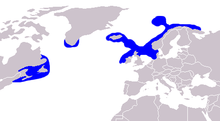Tusk
| Tusk | ||||||||||||
|---|---|---|---|---|---|---|---|---|---|---|---|---|

Tusk ( brosme brosme ) |
||||||||||||
| Systematics | ||||||||||||
|
||||||||||||
| Scientific name of the genus | ||||||||||||
| Brosme | ||||||||||||
| Oken (ex Cuvier ), 1817 | ||||||||||||
| Scientific name of the species | ||||||||||||
| Brosme brosme | ||||||||||||
| ( Ascanius , 1772) |
The tusk ( Brosme brosme ) is a fish from the tadpole family and the only member of the genus Brosme . As a result of the decline in many commercially used fish species, it was increasingly fished from the 1990s. This unregulated use led to a serious endangerment of the stocks, which is why the management of the species in the EU has been regulated since 2003 by both a permissible total catch and quotas.
distribution and habitat
In the western North Atlantic , the tusk can be found from New Jersey to the Belle Isle Strait and the Newfoundland Bank; it is less common around the southern tip of Greenland. Its distribution area extends from Iceland in the North Sea to the coasts of Scandinavia and the Barents Sea off Murmansk . The northernmost occurrences live in the waters around Svalbard .
The tusk lives ground-oriented over rock, scree, or gravel and on steep slopes. In the Gulf of Maine it can occasionally be found on muddy ground, and it usually avoids soft and smooth sandy ground. It stays away from both the coast and the shallow water and lives in water depths between 20 and 1000 meters. In the north-east Atlantic it is often found at depths between 150 and 450 meters, in the north-west Atlantic between 18 and 549 meters. The species tolerates a temperature range between zero and ten degrees Celsius.
features
The spindle-shaped body of the tusk can reach a total length of 110 centimeters. As a rule, however, the species grows up to a size between 60 and 95 centimeters in its eastern settlement areas and 50 to 80 centimeters in the western parts. The large head has a single barb on the lower jaw . The upper jaw protrudes slightly. Both the dorsal and anal fin are noticeably long and extend to the base of the caudal fin , with which they are partially connected. The pectoral fins end at a considerable distance from the beginning of the anal fin. The pelvic fins are throaty and fleshy.
The tusk is brown to gray in color with a lighter belly. Six yellow transverse bands on the sides of the body are possible in young specimens. The most striking color feature is a black border with a white border on the unpaired fins. The scales are very small and anchored deep in the thick, slimy skin. The sideline is complete until shortly before the approach of the caudal fin.
Fin formula : dorsal 93–103, anal 62–75
behavior
Crustaceans and molluscs make up the majority of the diet of the solitary tusk or in small groups , but it also prey on benthic fish. Its radius of action is relatively limited and is mainly limited to the change in water depth; there is no concrete evidence of pronounced hiking behavior.
At the age of eight to ten years, when it has reached a total length of 40 to 50 centimeters, the tusk becomes reproductive. Spawning takes place at depths between 100 and 200 meters and is very productive, a medium-sized female sheds up to two million eggs. The pelagic eggs, between 1.3 and 1.5 millimeters in diameter, slowly ripen near the surface. The offspring live pelagically up to a length of about five centimeters, after which they switch to a soil-oriented way of life. Lumbe grow slowly and can reach an age of 20 years.
Individual evidence
- ^ Fisheries in Europe . No. 14, October 2003, Directorate-General for Fisheries of the European Commission (Ed.), ISSN 1606-0814 . S.3,8 ( PDF; 1.7 MB ( Memento of the original from July 16, 2007 in the Internet Archive ) Info: The archive link has been inserted automatically and has not yet been checked. Please check the original and archive link according to the instructions and then remove this notice . )
- ↑ Council Regulation (EC) No. 43/2009 of January 16, 2009 . In: Official Journal of the European Union . L, No. 22, January 26, 2009, pp. 1-205, here: pp. 37-39.
- ↑ a b c d e f g h Daniel M. Cohen, Tadashi Inada, Tomio Iwamoto, Nadia Scialabba: FAO species catalog. Vol. 10. Gadiform Fishes of the world (Order Gadiformes) . FAO Fisheries Synopsis. No. 125, Vol. 10. Rome, FAO. 1990. P. 29–31 ( HTML , ZIP / PDF; 26.65MB ( page no longer available , search in web archives ) Info: The link was automatically marked as defective. Please check the link according to the instructions and then remove this notice. )
- ↑ AV Dolgov: New Data on the Distribution of Rare and New Fish Species in Russian Waters of the Barents Sea . In Journal of Ichthyology . Vol. 46, No. 2, 2006, ISSN 0032-9452 p. 143
- ↑ a b c d e Andreas Vilcinskas: Fish - Central European freshwater species and marine fish of the North and Baltic Seas. BLV Verlagsgesellschaft, Munich 2000, ISBN 3-405-15848-6 . P. 200
Web links
- Tusk on Fishbase.org (English)
